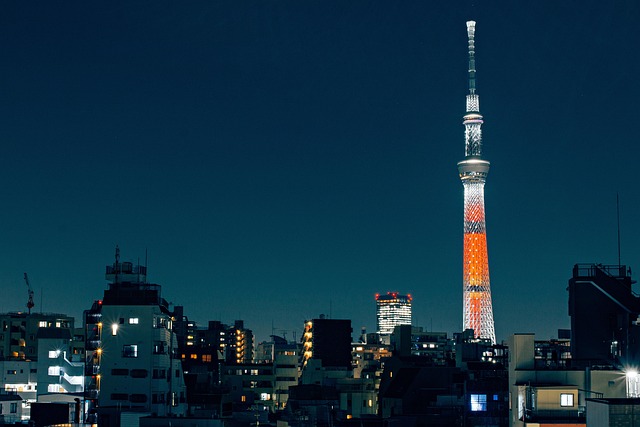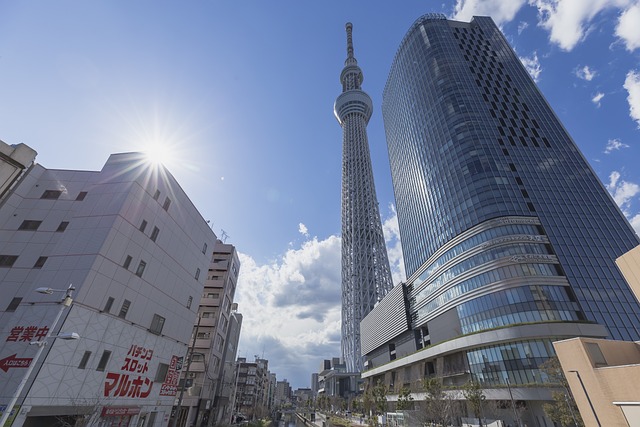When people imagine the skyline of Tokyo today, one structure rises above all others: the Tokyo Skytree. At a staggering 634 meters, it is not only the tallest structure in Japan but also the tallest tower in the world and the second tallest man-made structure overall, surpassed only by Dubai’s Burj Khalifa. Since its opening in 2012, the Skytree has become one of the most iconic landmarks of the Japanese capital, drawing millions of visitors each year. But the Tokyo Skytree is more than just a place to enjoy a panoramic view—it represents modern Japan’s blend of cutting-edge technology, cultural symbolism, and vibrant urban life.
Tokyo Skytree is Japan’s tallest tower, offering breathtaking views of the city and beyond.
The Birth of a New Landmark

The idea for the Tokyo Skytree emerged in the early 2000s, when Japan’s broadcasters realized they needed a taller tower to transmit digital television signals. Tokyo Tower, built in 1958 at 333 meters, had served this purpose for decades, but the rapid construction of skyscrapers around the city began to block signals. The solution was a new broadcasting tower that would stand more than twice the height of Tokyo Tower.
Construction began in 2008 and was completed in 2012. From the start, the project was not just about function but also about creating a new symbol for Tokyo. The design was chosen through a public competition, and the final concept combined elements of both futuristic architecture and traditional Japanese aesthetics. Its height of 634 meters was carefully chosen as a play on numbers: “634” can be read as musashi in Japanese, the old name for the Tokyo region.
Architectural Design and Symbolism
Tokyo Skytree’s design is a marvel of modern engineering. Its base starts as a triangular footprint, gradually transitioning into a circular shape as it rises, giving it both stability and elegance. This design ensures resistance to earthquakes and strong winds, a crucial feature in Japan’s seismic environment.
The appearance of the tower reflects both modern minimalism and traditional craftsmanship. Its exterior color, known as “Skytree White,” was inspired by aijiro, a light blue-white shade seen in Japanese indigo-dyed fabrics. At night, the tower is illuminated with two alternating themes: Iki, a sky blue tone symbolizing chic sophistication, and Miyabi, a purple tone symbolizing elegance and refinement. Seasonal and event-specific light displays, such as pink for cherry blossom season or rainbow colors for festivals, further enhance its role as a cultural beacon.
The architects also drew inspiration from ancient Japanese design. The gently curved lines of the tower echo the traditional forms of temples and pagodas, linking the futuristic structure with Japan’s long architectural heritage.
The Observation Decks: A View Above the World
The main reason most visitors come to the Tokyo Skytree is, of course, the view. The tower has two observation decks:
- Tembo Deck (350 meters): This three-level deck offers 360-degree views of Tokyo. On clear days, visitors can see Mount Fuji in the distance, Tokyo Bay shimmering to the south, and the endless sprawl of the city in all directions. The Tembo Deck also has a café, shops, and interactive digital displays that point out landmarks below.
- Tembo Galleria (450 meters): Known as the “world’s highest skywalk,” this deck features a sloping spiral ramp inside a glass tube. Walking along it feels like floating above the city. The glass floors and transparent walls create a thrilling experience, allowing visitors to sense the immense height beneath their feet.
The views from the Skytree change dramatically depending on the time of day. In the morning, the air is often clear, offering crisp, far-reaching vistas. In the afternoon, the golden sunset bathes Tokyo in warm light. At night, the city transforms into a glittering sea of lights, creating a magical and unforgettable atmosphere.
Tokyo Solamachi: Shopping, Dining, and Entertainment
At the base of the Skytree lies Tokyo Solamachi, a massive shopping and entertainment complex with over 300 shops and restaurants. Visitors can browse boutiques selling everything from traditional crafts and souvenirs to high-end fashion and lifestyle goods.
Food is another highlight. Solamachi offers a wide range of dining options, from casual Japanese street food to gourmet restaurants with views of the tower. Many visitors stop to try Tokyo-style ramen, freshly made sushi, or matcha desserts. For families, there are themed eateries and sweet shops that appeal to children.
One of the most popular attractions in Solamachi is the Sumida Aquarium, home to beautifully designed exhibits featuring penguins, jellyfish, and marine life from Tokyo Bay and beyond. The aquarium is known for its stylish presentation, combining natural beauty with modern design.
Cultural and Community Role
Tokyo Skytree is not just a tourist attraction; it has quickly become part of the daily life and identity of Tokyo. The surrounding district, once a quiet neighborhood in Sumida Ward, has been revitalized by the presence of the tower. Festivals, seasonal markets, and community events are often held at its base, attracting both locals and travelers.
The tower is also frequently used as a canvas for cultural expression. During national holidays, the illuminations often match the colors of the Japanese flag. In times of celebration or remembrance, the Skytree becomes a symbol of unity and hope. For example, special lighting displays have been used to show support after natural disasters or during major sports events such as the Tokyo Olympics.
Comparing Skytree and Tokyo Tower
Visitors to Tokyo often ask whether they should go to Tokyo Skytree or Tokyo Tower. The truth is that both towers have their own charm. Tokyo Tower, with its retro red-and-white design, is beloved for its nostalgic atmosphere and historical significance. The Skytree, on the other hand, represents modern Tokyo—taller, sleeker, and filled with cutting-edge technology.
While Tokyo Tower offers a more central location near Roppongi, the Skytree provides a more expansive view, thanks to its greater height. Ideally, travelers should visit both to experience how Tokyo’s skyline has evolved over the decades.
Practical Information for Visitors
- Location: Oshiage, Sumida Ward, Tokyo
- Access: Directly connected to Tokyo Skytree Station (Tobu Skytree Line) and Oshiage Station (served by the Hanzomon, Asakusa, and Keisei Lines).
- Opening Hours: Typically 10:00 AM – 9:00 PM (hours may vary seasonally or during special events).
- Tickets: Admission to the Tembo Deck and Tembo Galleria can be purchased on-site or online in advance. Prices vary depending on which levels you choose to access.
Visitors are advised to buy tickets online during busy seasons, such as cherry blossom time or year-end holidays, to avoid long queues.
A Symbol for the Future
The Tokyo Skytree is more than a place to admire the view. It is a symbol of Tokyo’s spirit—resilient, innovative, and deeply connected to tradition. For locals, it has become part of daily life, a familiar silhouette that marks the horizon. For travelers, it represents the essence of modern Japan, where the old and new coexist harmoniously.
Whether you are a first-time visitor to Tokyo or a frequent traveler, a trip to the Tokyo Skytree is an unforgettable experience. Standing at its observation decks, with the city stretching endlessly beneath you, you cannot help but feel the scale, energy, and beauty of one of the world’s greatest cities.



comment